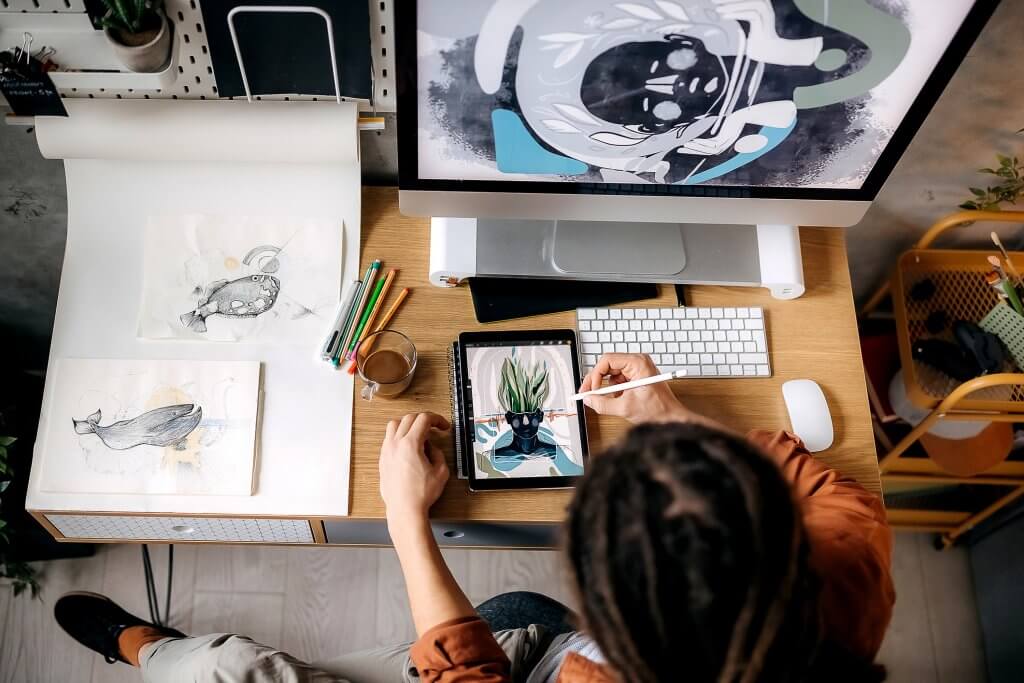19.04.2023 by Infogram
In today’s fast-paced digital world, data visualization has become an essential tool for businesses to communicate complex information quickly and efficiently. The ability to present data in a visually appealing and easy-to-understand manner can make all the difference in decision-making processes. And this is where graphic design plays a crucial role. With the right design elements and principles, you can turn monotonous data into captivating, informative visuals that tell a story.
And data visualizations aren’t the only visuals where graphic design practices are applied. Graphic design is everywhere – from logos, advertisements, websites, and billboards to product packaging, and more. It plays a role in how visual information is communicated and therefore is crucial in any project you want to deliver. In this article, we’ll dive into what graphic design is, how to do it, how to learn it, and how branding is an essential aspect of graphic design.
Click to jump ahead:
What is graphic design?
Why is graphic design important?
How to do a graphic design
How to learn graphic design
Graphic design examples
Sustainable graphic design practices
Conclusion

What is graphic design?
Graphic design is the art and practice of creating visual content to communicate a message to a specific audience. Graphic designers use various elements such as typography, color, images, and layout to create a visual representation of a message. The purpose of graphic design is to effectively communicate an idea and evoke an emotional response from the viewer using visual elements.
Why is graphic design important?
One may ask, why is graphic design important? Why should I apply graphic design principles to my projects? Well, the importance of graphic design lies in its ability to help you and your businesses effectively communicate your message to the intended audience. Whether it’s a logo, a website, a brochure, or a social media post, graphic design plays a crucial role in making the content look professional and engaging. In addition, it can also help you establish brand identity and recognition, which is vital in creating a lasting impression on consumers. Overall, the impact of graphic design cannot be overstated as it enhances the way we perceive and understand the world around us.

How to do a graphic design
If you’re looking to create a graphic design, you should consider the stages involved in crafting a visual project. To make it a success, make sure to follow the key steps we’ve listed below.
Identify the purpose and audience
The first step in creating a graphic design is to identify the purpose of the design and the target audience. You want to think about the goal and how your audience will perceive the design. Understanding the purpose of the design and who it’s intended for will help you create a design that effectively communicates the message.
Conduct research
Research is essential in creating a successful design. It helps to gather information about the client, the competitors, and the target audience. Also, it helps to identify trends and inspiration for the design.
Brainstorm
Once you’re done researching, you’ll already have some ideas on the type of design you want to have. What you want to do is dedicate some time to brainstorming, which involves generating ideas and concepts. Also, sketching is an essential part of the brainstorming process. It’ll help you visualize your ideas and allow you to explore different design options.

Create a draft
Based on the sketches and ideas generated during the brainstorming process, create a rough draft of the design. This involves creating a basic layout and selecting colors, typography, and other design elements.
Refine the design
Once you have a rough draft, refine the design by making adjustments and modifications based on feedback from the client and your own evaluation. This includes refining the typography, color, layout, and other design elements.
Finalize
Once you have refined the design, create the final version. This involves making sure that all design elements are consistent and balanced, and that the final product effectively communicates the message to the target audience.

How to learn graphic design
Graphic design is an academic discipline that you can choose to study at a university or learn in online courses. While it’s essential to learn it if you want to pursue a career in this field, it can also be beneficial for you to understand the basics if you’re a marketer, a creative director, a branding designer, or simply interested to add this skill to elevate your resume. If you’re interested in mastering this discipline, here are some ways you can learn graphic design:
Take courses
There are many graphic design courses available online and offline. These courses usually cover the basics of graphic design, typography, color theory, and other essential design elements. For example, you can discover graphic design courses on Coursera, Udemy, or Skillshare, to name a few learning platforms. If you prefer learning in person, discover courses in your local community – reach out to your family, or friends, or connect with graphic designers on LinkedIn and ask for course recommendations.
Practice
The more you practice, the better you become at graphic design. That’s why one of the best ways you can learn graphic design is by simply practicing designing different types of projects and experimenting with different design elements. After, ask for feedback from people around you or graphic designer communities on social media and see how you can improve your designs.

Learn from other designers
Social media is a great resource for you. Use it to network with other designers and learn from their experiences, which can help you grow as a designer. You can join design communities online or attend design conferences and events to meet other designers.
Stay up-to-date
Graphic design is constantly evolving, so it’s essential to stay up-to-date with the latest trends and technology. This means reading design blogs, following designers on social media, and attending networking events, which will help you stay current in the field.
What is branding in graphic design?
Branding is an essential aspect of graphic design. It involves creating a unique identity for a product, service, or company. An identity that extends beyond a logo; it’s the perception that people have of the product, service, or company. Branding can help you create a recognizable identity that sets you apart from competitors. If you’re looking to incorporate branding in your designs, here are the key elements that should contribute to your branding strategy:
Logo design
A logo is one of the most recognizable elements of a brand. It’s the graphic representation of a brand’s identity and should be simple, memorable, and easily recognizable. A well-designed logo can communicate the brand’s personality, values, and mission.
Color scheme
Color is an essential component of branding as it evokes emotions and creates a visual identity for a brand. A brand’s color scheme should be consistent across all marketing materials and should reflect the brand’s personality and values.
Typography
The font used in a brand’s marketing materials should be carefully selected to reflect the brand’s personality and values. The typography should be consistent across all marketing materials, and the font should be legible and easy to read.
Imagery
Imagery can be used to reinforce a brand’s personality and values. The images used in a brand’s marketing materials should be consistent with the brand’s identity and should be high-quality and relevant.
Brand guidelines
Brand guidelines provide a set of rules and guidelines for how a brand should be represented visually. These guidelines include information on logo usage, color schemes, typography, and imagery. Adhering to brand guidelines ensures consistency across all marketing materials and helps reinforce a brand’s identity.
In summary, effective branding in graphic design requires a cohesive visual identity that communicates a brand’s personality, values, and mission. Key elements include a well-designed logo, a consistent color scheme, carefully selected typography, relevant imagery, and adherence to brand guidelines. By including all these elements, you can craft an effective branding strategy that helps you stand out from the crowd.
Graphic design examples
If you’re looking to communicate a message with your data visualizations, you have to make sure to apply the best graphic design practices to effectively deliver your idea. Graphic design is all about visual communication, so what better way to understand the best graphic design practices than by looking at great examples and taking note of the visual principles used?
Infographic
This infographic is a great example of effective graphic design. With the use of a bold color scheme that matches the topic, simple and easy-to-read typography, and an interesting yet simple layout, the infographic catches people’s attention while efficiently communicating the message. What’s great about this design is that it considers visual hierarchy and uses size to draw attention to important information. Also, the animations added in the infographic make the whole design appear more dynamic and interesting to look at and engage with.
Dashboard
Dashboards are great for communicating data-rich information. The trick is to visualize it in an easily understandable and compelling way. The Year of Plant Health dashboard is a great example of how you can use color to tie in the different information you’re trying to show about one topic. While there are different types of data, the color scheme and icons on top create a cohesive look that’s pleasing to the eye. Also, the interactive map element adds another layer of dynamics to the design.
Report
This report example from APSCo Australia provides a cohesive and pleasant viewing experience as you click through the report. What’s great about this report is that it features a simple and clean design while catching the viewer’s attention with engaging transitions between pages and data visualization animations. What’s important to note is that the font is great for a report as it’s clean and easy to read. Plus, the sizes of headers follow key principles of visual hierarchy.
Slides
The presentation slides of Private Equity International, part of the PEI Group, provide a new level of an eye-catching viewing experience. The use of transitions between slides captures people’s attention and engages them to follow through with the presentation. Not to mention the interactive aspect of the presentation that invites the viewer to click on the tooltips and discover more data. Also, the use of brand colors makes it clear what the presentation is about.
Poster
Posters are all about catching people’s attention and conveying a message in the most straightforward way possible. It’s exactly what this poster does with the use of a laptop icon over the visualized map. If you’re creating a poster, make sure to use size effectively – highlight the most important information in bold and bring attention to the main point by making it appear larger than other design elements.
Social media post
Social media isn’t only for cat images or highly filtered photos. It’s also a great place to share meaningful data. In this social media post design, you can see how the choice of color can instantly grab your attention, and by choosing a clean background, the data you share will pop even more. Also, be sure to think about the placement of your data visualizations – always center the information you want people to see first.
Sustainable graphic design practices
By following the best graphic design principles, you can create designs that effectively and efficiently communicate your message. While you can save your colleagues time when sending a visually engaging and easily understandable report, it’s also possible to save on other resources when opting for sustainable graphic design, which is a topical subject matter that has surfaced in recent years.

Sustainable graphic design involves taking into account the environmental impact of the design process. The choices made regarding the shape, size, and color of a design can have far-reaching consequences. When it comes to printed designs, the type of paper, ink, and materials used can greatly reduce the carbon footprint of the design, resulting in fewer emissions and more efficient use of natural resources. For digital designs, there is also a carbon cost to consider. Additionally, a sustainable approach to graphic design includes being mindful of one’s working environment, the power consumption of equipment, and the companies whose products are used.
Conclusion
Graphic design plays a vital role in the way we perceive and understand visual information. It’s a powerful tool used to communicate complex information quickly and effectively in today’s fast-paced digital world. Whether it’s a logo, website, brochure, or social media post, graphic design principles enhance the visual appeal of the content and help establish brand identity and recognition. By following key steps such as identifying the purpose and audience, conducting research, brainstorming, creating a draft, refining the design, and finalizing the design, you can successfully create a graphic design. To learn graphic design, you can take courses, practice, learn from other designers, and stay up-to-date with the latest trends and technology. Also, branding is an essential aspect of graphic design, and it involves creating a unique identity for a product, service, or company. Overall, graphic design is an art and practice that is crucial in any project you want to deliver. If you’re inspired to start crafting your own, head over to Infogram and create a stunning design today!
Interested in discovering how Infogram can enhance your team’s work? Join a brief Zoom session with our Infogram representative to explore key features, get answers to your questions, and understand how we can assist. It’s quick, informative, and just like a coffee break chat. Schedule your call now!
Get data visualization tips every week:
New features, special offers, and exciting news about the world of data visualization.